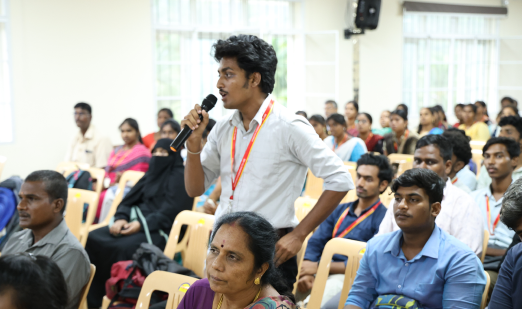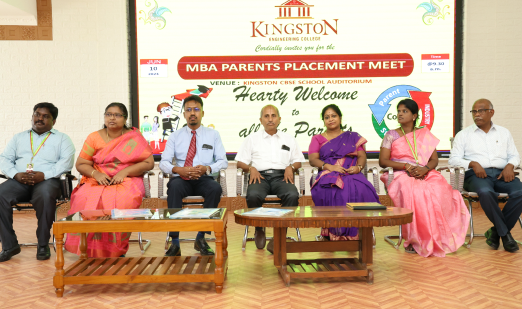Electrical and Electronics Engineering
Department Introduction
The Department of Electrical And Electronics Engineering was started in the year 2008. The annual sanctioned intake of B.E program in Electrical and Electronics Engineering is 120. The department is backed by a team of motivated, dedicated and experienced teachers graduated from institutions of good repute.
Power System had been a thrust area in Electrical Engineering. But with the advent of Power Electronics devices, the contemporary Power System had changed and it took a new phase. Power Electronics has significant role in various phases of Power System. The generation of electric power using alternative/ renewable energy sources has become very popular now a days. With the intention of giving the students to explore deep into the trending areas, the Post Graduate Programme in Power Systems was started in the year 2012 with an annual intake of 18.
- B.Tech Artificial Intelligence and Data Science

| Course | Intake |
|---|---|
| B.E in Electrical And Electronics Engineering | 120 |
| M.E in Power Electronics and Power Systems | 8 |

Vision Of The Department
- To build highly skilled, competent, ethical and versatile professionals with ability to design, develop, analyze and implement core engineering technologies to solve real time problems

Mission Of The Department
- To Train students to become well-balanced engineers taking into consideration society, safety and the environment
- To make the students suitable for industry.
- To import self-learning ability, and to drive the students for higher education and research.
/B.E. Electrical and Electronics Engineering
| PO | PROGRAM OUTCOMES |
|---|---|
| PO1 | Engineering Knowledge : Apply the knowledge of mathematics, science, engineering fundamentals, and an engineering specialization to the solution of complex engineering problems. |
| PO2 | Problem Analysis : Identify, formulate, review research literature, and analyze complex engineering problems reaching substantiated conclusions using first principles of mathematics, natural sciences, and engineering sciences. |
| PO3 | Design/Development Of Solutions : Design solutions for complex engineering problems and design system components or processes that meet the specified needs with appropriate consideration for the public health and safety, and the cultural, societal, and environmental considerations. |
| PO4 | Conduct Investigations Of Complex Problems : Use research-based knowledge and research methods including design of experiments, analysis and interpretation of data, and synthesis of the information to provide valid conclusions. |
| P05 | Modern Tool Usage : Create, select, and apply appropriate techniques, resources, and modern engineering and IT tools including prediction and modeling to complex engineering activities with an understanding of the limitations. |
| P06 | Apply reasoning informed by the contextual knowledge to assess societal, health, safety, legal and cultural issues and the consequent responsibilities relevant to the professional engineering practice. |
| P07 | Understand the impact of the professional engineering solutions in societal and environmental contexts, and demonstrate the knowledge of, and need for sustainable development. |
| P08 | Ethics : Apply ethical principles and commit to professional ethics and responsibilities and norms of the engineering practice. |
| P09 | Individual and Team Work : Function effectively as an individual, and as a member or leader in diverse teams, and in multidisciplinary settings. |
| P10 | Communication : Communicate effectively on complex engineering activities with the engineering community and with society at large, such as, being able to comprehend and write effective reports and design documentation, make effective presentations, and give and receive clear instructions. |
| P11 | Project Management and Finance : Demonstrate knowledge and understanding of the engineering and management principles and apply these to one’s own work, as a member and leader in a team, to manage projects and in multidisciplinary environments. |
| P12 | Life-long Learning : Recognize the need for, and have the preparation and ability to engage in independent and life-long learning in the broadest context of technological change. |
| PEO | Programme Educational Objectives |
|---|---|
| PEO1 | To prepare under graduate students to excel in technical profession/ industry and/or higher education by providing a strong foundation in mathematics, science and Engineering. |
| PEO2 | To transform engineering students to expert engineers so that they could comprehend, analyze, design and create novel products and solutions to Electrical and Electronics Engineering problems that are technically sound, economically feasible and socially Acceptable. |
| PEO3 | To train students to exhibit professionalism, keep up ethics in their profession and relate engineering issues to address the technical and social challenges. To develop communication skills and team work and to nurture multidisciplinary approach in problem solving. |
| PSO | Programme Specific Outcomes |
|---|---|
| PSO1 | Apply knowledge of Electrical Drives and Control systems to identify & resolve the problems in Industries. |
| PSO2 | Apply the concepts of Power Systems Engineering and Power Electronics to maintain the quality of electrical power delivered to Industrial and domestic consumers. |
College Academic Calender
R2013-B.E-EEE
Download PdfR2013-M.E-EEE
Download PdfR2017-B.E-EEE
Download PdfR2017-M.E-EEE
Download PdfR2021-B.E-EEE
Download PdfR2021-M.E-EEE
Download PdfThe budding engineers of our department experience practical realization of their theoretical concepts by indulging themselves in the following Workshops and Laboratories of the Department.
- Engineering Practices Laboratory
- Electric Circuits Lab
- Electronics Laboratory
- Electrical Machines Laboratory-I
- Electrical Machines Lab II
- Linear and Digital Integrated
- Circuits Laboratory
- Technical Seminar
- Control and Instrumentation Laboratory
- Professional Communication
- Microprocessors and Microcontrollers Laboratory
- Power System Simulation Laboratory
2016-17:
1. C Srinivasan, K Aruloli, “Design and Implementation of HDMI Transmitter”, International Journal of Engineering Research and Applications, Volume 6, Number 11, 2016, pp. 09-12(4)
1. C Srinivasan, K Aruloli, “Design and Implementation of HDMI Transmitter”, International Journal of Engineering Research and Applications, Volume 6, Number 11, 2016, pp. 09-12(4)
2. S Deepa, B Yuvarani, “ANN based correlate control of non-conventional energy sources and batterie in islanded microgrid”, 2016, 2nd national conference on recent innovations in engineering, technology, management and applications
3. S. Deepa,P. Vanaja Ranjan, B. Thulasi Brindha, N. G. Sowmya, “FPGA based Implementation of Adaptive Notch Filter”, IOSR Journal of Electrical and Electronics Engineering (IOSR-JEEE) , Volume 11, Issue 6 Ver. IV (Nov. –Dec. 2016), PP 88- 90
S Deepa, P Vanaja Ranjan, “Smart monitoring of machine health diagnosis”, Wulfenia (Accepted) (2016)
S Deepa, P Murugesan, C Sharmeela, “A Soft computing technique for characterization of power quality events”, Journal International journal for research in applied science and engineering technology, 2017, Volume 5, Issue 12
2017-18:
1. S Tamilselvi, S Baskar, L Anandapadmanaban, KMA Kadhar, PR Varshini, “Chaosassisted multiobjective evolutionary algorithm to the design of transformer”, Soft Computing 21 (19), 5675-5692-3-2017.
2. S. Jayachitra; G. Baskar; T. Feridinand, “Application of mutation inspired constrained factor PSO considering voltage stability and losses by locating and rating TCSC during N-1 contingency”, International Journal of Reasoning-based Intelligent Systems (IJRIS), Vol. 10, No. 3/4, 2018
2017-18:
1. D.Prabhatharan, S. Deepa, “VLSI implementation of DWT for image compression”, RTEECE’19, SBCEC, Arni on 12.3.2019, pp.213-217.
2019-20:
1. B Thulasi Brindha, T Raghunathan, “Modified PMSG system using Trans Z Source network for grid connected UPFC system”, AICTE sponsored national conference on recent advances in on-board ship automation-RAOBSA 2019, 26th& 27th September 2019 at AMET deemed to be University-Chennai.
Patents
| S.No | Names | Date of Submission | Title | Application Number | Published (Y/N) |
|---|---|---|---|---|---|
| 1 | Dr Halavath Balaji Karnam Sreenu G Prasadu Dr S Deepa N Ramesh Mr Yogesh Mohanrad nigadu Prof Dr SB Chordiya Dr Yashpal Singh | 27.06.2019 | IRSC Machine - Intelligent Rotation Speed Control machine | 201941025655 | Yes |
Proposals Submitted:
AICTE - Research Proposal scheme - Rs 25 Lakhs - 2016-17- An FPGA based Real time fault diagnosis in electrical systems
DST-Women Technology Park for Rs.90 Lakhs in the Academic year 2016-17- Training for rural women to enhance safety and power conservation
Scholars pursuing Research at our Research Centre :
| S.No | Name/Designation of the Scholar | Reg.No | Title | Publications |
|---|---|---|---|---|
| 1 | Mr D Prabhatharan, AP/ECE, Adhiparasakthi College of Engineering, Kalavai | 17144997343/Ph.D/AR7 | Reconfigurable VLSI architecture for image compression | Conference-1 |
| 2 | Mr S Narasimman, AP/EEE, Adhiparasakthi College of Engineering (APCE), Kalavai | 18143991235/Ph.D/AR11 | Torque ripple minimization in BLDC | - |
| 3 | Mr N Ramesh, AP/EEE, Adhiparasakthi College of Engineering , Kalavai | 18234991584/Ph.D/AR11 | Development of instrumentation for smart grid | - |
Research & Development in Electrical Machines Laboratory:
Texmo – Industries have sponsored a submersible motor set to our students for Research & Development purpose.
Rank holders – list
| SI.No | Reg.No | Name of the student | Class | UG/PG |
|---|---|---|---|---|
| 1 | 52409105057 | Vignesh M | FWD | UG |
| 2 | 52409105033 | Preethi M | FWD | UG |
| 3 | 511314105056 | Priyadharshini B | FWD | UG |
| 4 | 51131341117 | Vimalraj M | FWD | UG |
| 5 | 51131341101 | Abinaya R P | FWD | UG |
| S.No | Name of the Faculty | Project Title | Funding Agency | Status |
|---|---|---|---|---|
| 1 | Dr.Rajeswari.Perepi, Mrs.M.Menaka, Mr.M.Tamil Thendral, Ms.S.Sarah, Ms.S.Sivasankari | Innovative Teaching Practices and Methods For Developing Educational Projects In Schools Based on 3D Printing Technology | Kingston Matric Higher Secondary School | Applied |



